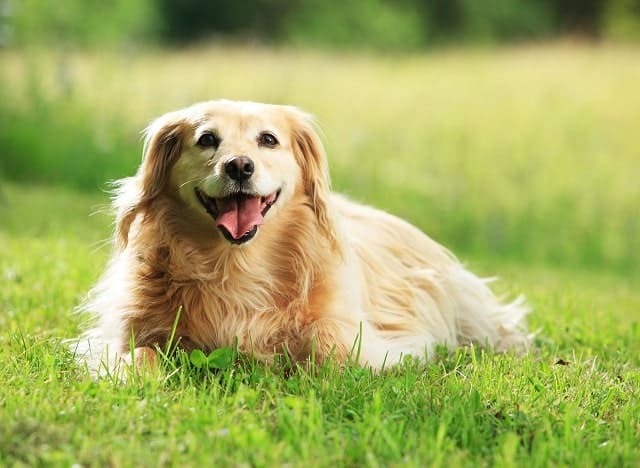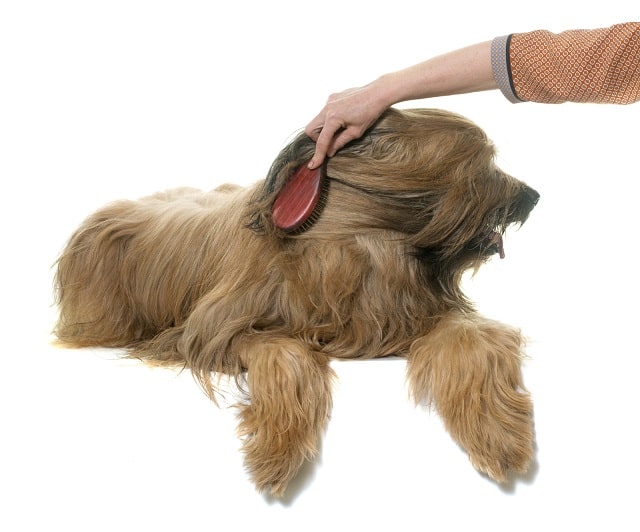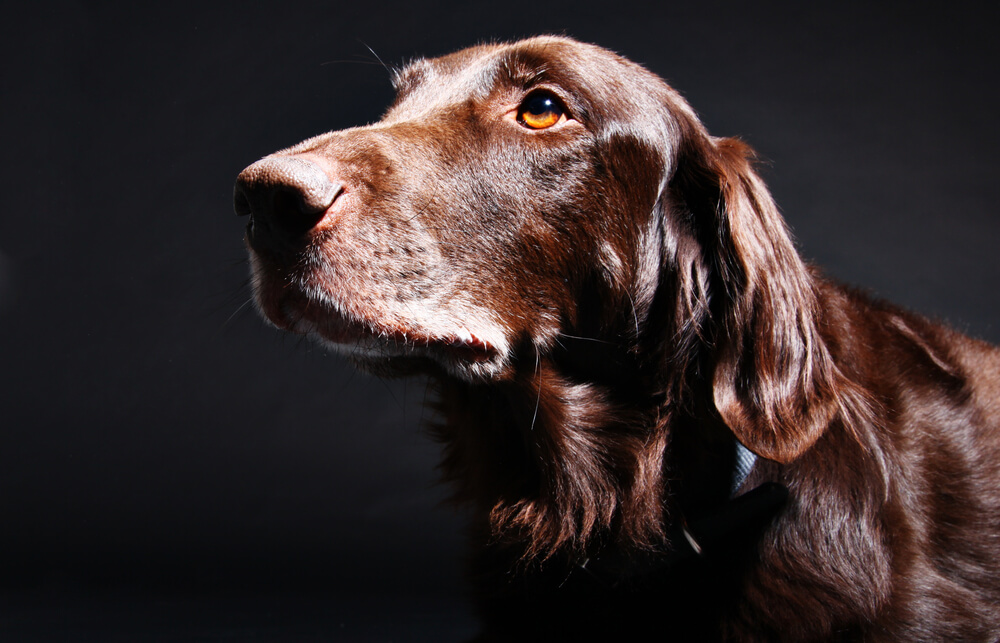As a veterinarian, I’m often asked how to make a dog’s coat shiny. Not all breeds have naturally shiny coats, but in some dogs, a dull coat can be an indicator of an underlying health condition. Here’s what you need to know about the potential causes of a dull coat and what you can do to ensure your pup maintains a shiny, healthy coat.
Should Your Dog’s Coat be Shiny?
Often people associate a shiny dog coat with being healthy. In many dog breeds, this may be true. Sure, that Golden retriever with the long flowing fur, we expect it to be shiny. But a bulldog? A boxer with their bristly fur?
So, first, ask yourself, should your dog’s coat be shiny? Was it always dull, and you read something that suggested it should be shiny? Or was it shiny, and now something has changed, and it has lost its luster?
Have you noticed any dry skin, redness, itchiness, dandruff, or loss of fur? Have you recently changed your pet’s food? Added or removed any treats or supplements?
If you answered yes to any of these questions, perhaps there is an underlying cause. If you answered no, then then your pet may not need to have a shiny coat.
Possible Causes of a Dull Coat

Your dog’s skin is an important part of the immune system, providing a level of protection from the environment. It also helps to keep your dog’s temperature normal and allows for the sensation of touch.1
Causes for a non-shiny hair coat may include the following.
1. Allergies
Allergies can include environmental allergies, such as pollen, dust mites, or ragweed, and diet-related allergies. A diet-related allergy is an allergy to a specific protein in food, such as chicken or beef.
Signs of allergic skin disease may include patchy fur loss, changes in texture, shine, biting, chewing, or licking at a specific area, or general overgrooming. You may see redness or pimple-like areas.2
2. Diet
Your dog’s diet could be contributing to a dull coat in several ways:
- Protein allergy
- An incomplete diet; malnutrition; poor-quality food
- Change in food (new brand, new flavor, new formulation)
3. Stress
Have you ever gotten pimples when you were stressed? Have you ever noticed your dog gets dandruff when going to the vet?
When stressed, the body acts in numerous ways. Dandruff and increased shedding may occur during or after a stressful event. This is usually a short-term issue not warranting treatment. However, repeated stressors can weaken the skin’s protective barrier and lead to skin and coat changes.
4. Medical conditions
Diseases such as diabetes, Cushing’s disease, or hypothyroidism can cause various skin changes. These diseases often have accompanying signs, such as changes in how much a pet drinks, weakness, lethargy, or weight changes. But sometimes skin changes or coat changes are the first signs.
5. Ectoparasites
Fleas, ticks, scabies (mange), Demodex, and other ectoparasites, depending on where you live, can cause infection and changes to the coat and skin. Always ensure safe, effective monthly parasite prevention. Speak with your veterinarian for specific product recommendations.
6. Environmental conditions
In winter, our homes become drier. Have you ever had dry, chapped hands in the winter? A dog’s skin can react similarly. Shining up your dog’s coat may be as simple as changing your home’s humidity level.
7. It’s not supposed to be shiny
Your dog’s breed naturally may not have a shiny coat. So, just because a coat isn’t shiny doesn’t mean it isn’t normal.
How to Make a Dog’s Coat Shiny: 7 Steps Towards a Healthier Coat

Follow these steps to help your dog regain a beautiful, healthy, shiny coat.
1. Ensure proper nutrition
An excellent quality, fully balanced dog food may be all your pet needs. However, if your dog is already on a great diet, it’s possible that there is an allergy to a protein in the food (chicken, beef, or fish, for example).
Some people consider raw food diets or home-cooked diets, thinking that this will fix a dull coat. While a diet change may be warranted in some cases, consider the safety risks of raw food diets and the risk of malnutrition associated with them.
If you choose to cook for your pet, please consult a board-certified veterinary nutritionist or service that can help you perfectly balance the food. (See additional resources below).
We also have a lot of resources on your dog’s nutrition that can help. We can help answer the question of how long does it takes a dog to digest food. We also have a dog weight predictor, dog growth charts including our goldendoodle size chart, great dane size chart, chihuahua size chart, labrador size chart, and golden retriever size chart (and our general overview of a dog’s ideal weight), and our list of foods dogs can not eat.
a guide to how much your dog should weigh, and we even have a list that answers the question what foods can dogs not eat?
2. Bathing
Generally speaking, most dogs don’t need to be bathed regularly. However, dogs who play in the dirt/mud may need a bath, and puppies or senior dogs who soil themselves may need a bath.
Frequent bathing in pets that do not have underlying skin disease is not recommended because bathing removes the natural oils in the skin. It causes damage over time to the natural protective measures the skin possesses. An increase in dandruff and shedding may occur after bathing for a day or two. Once the natural oils replenish, this usually resolves.
Steps to proper bathing
If your dog does need a bath, follow these steps to properly bathe your pup:
- Ensure your pet is comfortable with bathing. Don’t force your pet into a shower or tub. (See Cooperative Care information below).
- Avoid putting shampoo directly on the face/ears, and try to keep these areas relatively dry.
- If your pet isn’t itchy and has normal skin, bathing in warm water is feasible. However, in general, and especially if the dog is itchy, cool water should be used. Why? Because warm water dilates (opens) the blood vessels and brings the blood flow closer to the skin’s surface. This increases itchiness. So, using cool water minimizes this. If you’ve ever bathed your dog, and they were itchier after, this may be why.
- Wet your pet, then use shampoo as discussed below.
Drying recommendations
After bathing, make sure to dry your pet well. Take special care to dry the ears inside and out as a wet ear can lead to infection.
Should you towel dry your pup or use a dog grooming dryer? That is up to you AND your dog. Some dogs take well to them, but others, not so much. They are loud, blow air, and are foreign to most dogs. When using a hairdryer, keep it in the lowest setting and no or minimal heat. For towels, consider a microfiber towel for quick drying as they absorb a lot of water.
Shampoo options, conditioners, mousse
The product you use matters. Here are a few tips to help you choose the right products to bathe your pet.
- Make sure the product you use is labeled for dogs.
- Be cautious with over-the-counter products that spout medical claims. These products are not tested or supervised by the FDA, so the medical claims are not proven.
- Human shampoos are a no-no. Our skin makeup is different from dogs’ skin.3 Additionally, the ingredients may not be safe.
- For routine bathing, an oatmeal shampoo is mild and safe enough for most pets.
- If there are patches of fur missing, redness, or itchiness, then ideally you should talk with your veterinarian first. However, if you choose to buy an over-the-counter product, consider one with antibacterial and/or antifungal properties. These often include ingredients like Chlorhexidine or Ketoconazole. Ingredients such as phytosphingosine can be calming to those with itching or irritated skin. Other ingredients help if the skin is greasy or for general itchiness. Again, talk to your vet before using any over-the-counter products in this case.
- For most products, a minimum of 5-10 minutes of contact time is needed. That means you’ll need to get your dog wet, lather them up, distract them, and keep them busy for 5-10 minutes before rinsing them off. Otherwise, the products will work correctly.4
- I suggest a bath lick mat of some kind that suctions to the wall or tub. You can use wet food or peanut butter frozen as a treat.
- Suppose your dog gets something greasy, sticky, or otherwise stuck in their fur. In that case, your best bet is the Original Dawn® dish detergent, developed to use on animals in oil spills. I recommend that everyone with a pet keep this in their home for emergencies.
Topical ectoparasite medications
If you use a topical flea/tick product for parasite prevention, such as Revolution® or Frontline Plus®, among others, make sure that you do not bathe your dog for 24-48 hours before or after applying the product. These products need the dog’s natural oils to spread properly, so it’s important to wait to let that repopulate after bathing.
3. Brush regularly
Brushing your dog regularly prevents matting of the fur. Matted fur can lead to skin infections and be painful to the pet. Even if your pet doesn’t need to be bathed, regular brushing can be helpful if well tolerated.
Regular brushing helps the human-animal bond; it connects you with your dog. It also helps remove debris, dead skin cells, pollen, and loose fur.
Sometimes, all you must do is brush to get that shiny coat. Some brush suggestions include the King Komb, which I found recently and love. My dog, who is afraid of most things, enjoys it. An added plus is that it is great to run through bedding (either a dog’s or your own), easily getting fur off most fabrics.
My other go-to is the Furminator (read our review of the furminator) . Some dogs may find this a bit more painful, especially if their fur is tangled. But it is also a great brush that comes in a variety of sizes.
If you have an Australian Shepherd we also have a break down of the best brushes for an Australian Shepherd.
4. Ensure routine monthly parasite prevention (topical or oral)
Fleas can commonly cause skin disease. Many pets are allergic to flea bites, which can cause fur loss, often starting around the rump, tail base, and along the dog’s back.5 It may only start as a change in fur coat quality.
Routine monthly prevention can prevent pests, prevent allergic skin disease, and keep your pet healthy from infectious diseases.
5. Consider vitamins, minerals, or supplements
Omega-3 fatty acids may be of benefit for some dogs. For the average, healthy dog who eats a good quality, fully AAFCO balanced diet, you shouldn’t need to add anything to the diet.
Dogs with underlying skin disease, gastrointestinal disorders, and a few other ailments may benefit from some additions such as higher levels of omega-3 fatty acids or occasional individual supplements.6 However, the average dog DOES NOT need supplements regularly.
These products, unless prescription strength, are not regulated by the FDA. Many products out there (animal or human) often do not undergo any testing for safety, effectiveness, or quality assurance testing. Always talk to your veterinarian first before adding any of these types of products.
Some reputable companies make dog food with higher amounts of omega-3 fatty acids added to help with skin, allergies, and coat quality. They may be labeled as skin and coat or sensitive skin. These may be sufficient to benefit your pet but can take 4-8 weeks or more to demonstrate an effect.
Finally, some topical products contain fatty acids that may help improve the overall skin protective barrier. However, additional studies are still needed for proper dosing and formulations.7
Always remember, ANY change in food should be done slowly. Slowly wean down the current food over 5-7 days while slowly increasing the new food to prevent GI upset. Adding a supplement like a fatty acid could lead to GI upset, so be sure to monitor your dog closely when you add anything new.
6. Minimize stress
Use Cooperative Care to train your dog to accept bathing, grooming, nail trims, and more calmly and effortlessly. Keep your pet well-exercised and mentally stimulated, and don’t force your dog to do something they don’t want to do. What you may think is fun for your dog might be stressful, so keep this in mind when assessing your pet’s coat and overall health and needs.
Some dogs love the bath, the attention, and the brushing, but others are afraid of the brush or the water. Some are afraid of the bathroom rug or the shampoo. If you want to learn how to make bathing, brushing, or grooming your dog less stressful for both you and your pup, then I suggest some reading and training with your dog.
Cooperative Care is allowing your pet to have a voice and willingly participate in the event. Please see these resources for additional information:
To reduce stress you’ll also want to make sure your dog is getting enough rest and your puppy is sleeping through the night, and that your dog has a comfortable bed. You can use our series of dog bed guides to find the right bed for your dog, including our guide to evaluating the best waterproof dog bed, our breakdown of the best outdoor dog beds, our look at the best elevated large dog beds, or our guide to selecting the best sofa dog beds.
7. Have your pet evaluated by your veterinarian
If you don’t see results with gentle bathing a few times a week or merely brushing your pet every day, the next step is to check with your veterinarian. Your veterinarian can evaluate your dog for potential underlying medical causes of changes in fur quality, texture, or appearance.
If you Google how to make Fluffy’s coat shinier, what will you find?
You may see various suggestions. Some will be safe and healthy, but others will be potentially harmful to your pet. Some may have no science to back up the recommendations, while several may have your veterinarian’s support behind them.
A few words of caution
Sadly, there is a lot of misinformation out there. Remember there is no immediate fix for skin disease, dull coats, or itchiness. Dogs may have underlying allergies that need to be addressed. Keep in mind that allergies can be managed, but never cured. They may have a skin infection that the over-the-counter shampoos may not entirely treat, or they may have an underlying illness that needs to be addressed. Be careful using Dr. Google for pet advice.
If you try one or two things, such as a specific shampoo or different food, but in 2-4 weeks your pet still hasn’t improved, please schedule an appointment with your veterinarian. A medical cause could be present, or stronger or different types of topical applications may be needed. If at any time your pet is getting worse, seek care sooner.
A Few Important Things to Remember
First, ask yourself if your pet’s coat should be shiny. Was it shiny, and now isn’t? Why?
We’ve provided some recommendations for bathing, drying, brushing, and grooming in general. Always ensure you’re feeding your dog a reputable well-balanced diet. Make sure your home isn’t too dry or too humid.
Second, don’t be discouraged if you try something and don’t see immediate results. Even prescription shampoos, conditioners, supplements, or a diet change can take 2-4 weeks to see sufficient improvement.
Finally, if you aren’t getting the success you are seeking, other concerns arise, or the coat isn’t shiny, talk to your vet. Likewise, if dandruff, skin lesions, itchiness, redness, or GI signs (vomiting/diarrhea) occur, please see your veterinarian.
Additionally, while you’re bathing and grooming your pet, you can also consider dog ear wax cleaner to keep your pup’s ears clean.
Additional Resources
If your pet has more than just a dull coat, see this article by Dr. Wendy Brooks. It talks about some of these very topics and offers some information specifically on itchy dogs.
Here are a few resources to help balance a home-cooked meal:
- Petdiets.com
- BalanceIt.com
- University of Tennessee Veterinary Nutrition Service (email: utvns@utk.edu)
- University of Missouri (email: datzc@missouri.edu)
Article Sources
Pet News Daily uses only high-quality sources, including peer-reviewed studies, to support the facts within our articles. Read our editorial process to learn more about how we fact-check and keep our content accurate, reliable, and trustworthy.
- Moriello K. Structure of the Skin in Dogs. Merckvetmanual.com. Updated June 2018. Accessed March 2, 2021.
- Barnette C, Ward E. Allergies in Dogs. Vcahospitals.com. Accessed March 2, 2021.
- Loria K. Allergic, parasitic, and viral skin disease treatment toolkit. Veterinarypracticenews.com. Published April 16, 2018. Accessed March 2, 2021.
- Zabel S. Shampoo use in Veterinary Medicine. World Small Animal Veterinary Association World Congress Proceedings. Jeju, Korea: Vin.com; 2011. Accessed March 2, 2021.
- UC Davis School of Veterinary Medicine. What About Allergies? Vetmed.ucdavis.edu. Accessed March 2, 2021.
- Mueller RS, Fieseler KV, Fettman MJ, Zabel S, Rosychuk RA, Ogilvie GK, Greenwalt TL. Effect of omega-3 fatty acids on canine atopic dermatitis. J Small Anim Pract. 2004 Jun;45(6):293-7. doi: 10.1111/j.1748-5827.2004.tb00238.x. PMID: 15206474.
- Sousa CA. Treatment of Canine Pruritus. American Board of Veterinary Practitioners (ABVP) Symposium. Vin.com; 2015. Accessed March 2, 2021.

